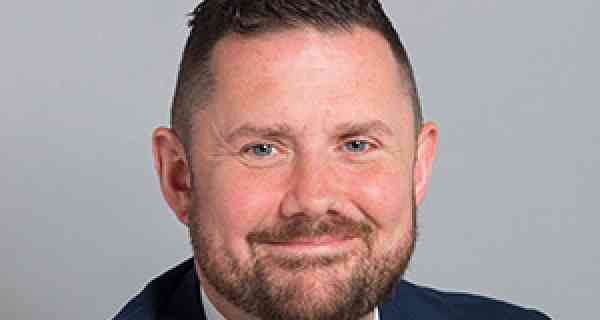Crowdguard will be exhibiting at Stand C50 at the International Security Expo 2025 from 30th September – 1st October, showcasing practical Hostile Vehicle Mitigation (HVM) solutions that protect people and places without disrupting how spaces are used.
GB Q&A: Tackling climate change and going green in Brighton
Government Business talks to Councillor Phélim Mac Cafferty, leader of Brighton & Hove City Council and co-chair of the 2030 Carbon Neutral Member Working Group, about moving towards a green recovery and the council’s Food Strategy Action Plan
GB: Central to the city’s 2030 ambition is taking a joined-up approach to delivering projects and initiatives that facilitate behaviour change. What actions are in place to bring about such a change?
We’re embracing the challenge of bringing together people, projects and actions to tackle the climate and biodiversity emergency. Brighton & Hove is a place where there is appetite for change and people who want to do things that will make a difference.
We’ve joined up our approach and activities by creating a 2030 carbon neutral programme. Agreed last year this is overseen by officer and cross-party member working groups where we share progress and learning which is then taken forward into actions.
Our actions on transport and travel behaviour change have been informed by our climate assembly held in 2020. Residents said they wanted us to focus on the positive benefits, rather than restrictions, of behaviour change. Along with building infrastructure that makes it easier to walk and cycle, we’re providing incentives through our Move For Change campaign, offering cycle training, expanding our bike hire scheme and providing e-cargo bikes for business.
We’re encouraging visitors to travel sustainably and enjoy the countryside around the city more through promoting the benefits of sustainable tourism, and we’re now one of the top five councils in the country for our electric vehicle charging points network.
In communicating and engaging on these actions we’ve joined with public health, local business and employers to educate, inform and persuade people of the benefits of sustainable transport and travel, with a focus on the benefits for personal health and cleaner air.
We’re making it easier for people to change behaviour around waste, bringing facilities to recycle textiles and tech equipment to streets and doorsteps, supporting sustainable business in the council-owned Brighton Open Market where people can learn how to repair or repurpose things, and buy or swap sustainably.
We’re now putting in place ways to build on that momentum and draw out more of the actions happening on behaviour change to see what is and isn’t working, and to find where the gaps are.
To do this we are mapping what behaviour change projects and campaigns are already happening and we’re in the early stages of setting up a climate partnership, to take forward and accelerate change.
GB: How has the council responded to the coronavirus pandemic to deliver a green recovery?
Brighton & Hove is a coastal and cultural destination. During the pandemic, businesses in the tourism, hospitality, events and attractions sectors were badly hit, with many small businesses, employees and freelancers (Brighton & Hove is one of the freelance hotspots in the UK) losing their sources of income.
Just before the Covid-19 pandemic we launched Brighton & Hove’s economic strategy with the Brighton & Hove Economic Partnership. This gave us a head start as one of its aims is to create a sustainable economy for the city, focusing on finding solutions to the challenge of climate change and creating new opportunities to minimise waste and pollution.
At the start of the lockdowns we set up a Covid recovery events and economy working group to respond and support our businesses, community and voluntary sector through the pandemic. This is supported by a Recovery Sub-Committee where we’ve been able to ensure that the sustainability of recovery plans are a key aspect of our approach and are underpinned by our carbon neutral programme.
A Tourism Recovery Programme launched in June last year capitalises on the desire for people to holiday more sustainably in the UK. This fed into initiatives such as the sustainable events strategy. Brighton & Hove was the first council to get the British Standard in Sustainable Event Management which supports everyone in the event supply chain – from organisers and venues though to performers and suppliers of food and drink – to take into account environmental issues such as local sourcing, waste and transport as part of event planning.
It has also been an important aspect of the Greater Brighton partnership which looks at wider recovery in the region. Alongside supporting businesses with grants and other opportunities to support them in the short-term, we’re jointly developing a Blue/Green investment plan and trialling the use of hydrogen as an alternative energy source.
We’re taking the opportunity to learn lessons from the pandemic that we can change and do things differently. We see it as an opportunity to nurture the city’s creative spirit and are using council-owned buildings or land to provide innovation workspace for product development and start-ups.
With two universities, we are well placed for innovation. The University of Brighton’s Green Growth Platform is an award-winning network for businesses. We’re collaborating with schools, colleges, universities and job centres on developing learning, skills and new career paths.
GB: The council’s Food Strategy Action Plan is believed to be the most ambitious in the UK. How is the plan helping the city adopt a sustainable food system?
The food strategy is an amazing piece of work put together by the Brighton & Hove Food Partnership. Started by a group of local residents, the Food Partnership is a not-for-profit organisation that works across the city with community organisations, statutory agencies, local businesses and individual residents.
The council helps to fund the partnership which led the city to win Gold Sustainable Food City Status in 2020 and we’ve adopted the Food Strategy Action plan in our own organisation.
Brighton & Hove’s Food Strategy Action Plan gives us an approach and framework to help us transition to a heathy, sustainable and fair food system. It has a clear vision and substantial local support. A city-wide effort sets the example and creates many paths for the changes that need to happen – this includes everything from affordable food projects, community kitchens, gardens and volunteer schemes.
Actions from the strategy contribute across a range of council departments and partnership plans. Importantly, they provide a route to ensure social as well as environmental justice and sustainability. Policy is key in ensuring real and lasting change, so evidence that activity is embedded for the long term is continuously monitored. Some action areas are further ahead than others at any one time, but the strategy guides the whole food system approach.
The Food Strategy helps us to champion diversity, independence and innovation, and we share knowledge with other places on how achievable actions can help transform food systems.
As a city that is a signatory of the Glasgow Food and Climate declaration, partners recognise that urgent action is required, at scale, to have an impact. The council is playing its part across its services to support the transition to a sustainable city-region food system.
GB: How important is reducing transport emissions in reducing the council’s carbon footprint?
Emissions from transport are around one third of the total emissions from Brighton and Hove, so if our city has any chance of becoming carbon neutral, we have to change the way we travel.
Transport emissions also affect air quality. We know that nitrogen dioxide, mainly from traffic, is causing a public health emergency and has to be addressed.
As a large proportion of emissions in the city come from travel and transport, it is essential that we adapt the way we move around to have any chance of achieving net zero emissions in Brighton & Hove.
Although the council owns the highways network and has some control over transport and traffic management, we know that we can only succeed in drastically reducing emissions if the wider city supports the change from using petrol and diesel vehicles to more sustainable travel choices.
Our climate assembly in 2020 focused on transport and explored the changes we need to make to reduce the carbon footprint of travel.
Since then, we’ve been looking into how we can best put these suggestions into practice and how they fit into wider transport plans such as our Local Transport Plan and a newly adopted Local Cycling and Walking Infrastructure Plan.
We’ve started a once-in-a-generation transformational programme of works to radically reduce the transport-related carbon emissions in the city.
Some of the actions we’ve taken include creating a new city centre park and sustainable transport connections in Valley Gardens and introducing a ‘school streets’ scheme to reduce the impact of the school run by reducing traffic emissions on main roads and around schools. The city has an ultra-low emissions transport zone and is working with bus companies on low emissions public transport.
We’re developing plans for a clean air city, including a liveable city centre, an expanded Ultra Low Emission Zone, low traffic neighbourhoods and mobility hubs.
GB: Brighton & Hove City Council recently received an overall score of ‘B’ from the Carbon Disclosure Project. What pointers have been noted for the next steps to tackle climate change?
Our CDP score reflects the many projects and activities underway to address the climate and biodiversity emergencies, and our commitment to embedding climate change actions across all our services.
One area the council is currently developing is how we tackle the likely risks of the climate changing, such as heatwaves, higher rainfall and the potential for flooding, more storms and high winds. We are working on understanding the risks and vulnerabilities in the city so that we can protect our communities.
Air pollution is a major concern for residents and we’ll shortly be consulting on our next air quality action plan. This will map out how we can work together on long-term solutions to tackle poor air quality wherever it occurs in the city.
Many of the carbon emissions in our city come from consumption – things like food and clothing that are purchased in Brighton & Hove but manufactured elsewhere in the UK or in other countries. The council is creating a network of community champions who will promote reuse, repair and recycling in their communities. This will help to cut down the ‘consumption’ emissions.
Along with cutting carbon emissions, we also need to tackle the crisis in biodiversity, such as the decline in song-birds and insect life. The council is developing a Downland Plan to work with organisations in Brighton & Hove to protect our precious chalk downland. We’re also stepping up tree planting in city parks and planting native wildflower verges. We want to develop projects to capture and lock away carbon in plants and trees that will also help our shared green spaces to flourish.

Event Diary
An essential date in the calendar for those responsible for homeland and global security; International Security Expo returns to Olympia in London on 30 September & 1 October 2025.
Every sport, from grassroots football to world-class tournaments, depends on one constant: high-quality playing surfaces and well-maintained green spaces.
Tickets: Free registration available at www.retailscl.com
The Retail Supply Chain & Logistics Expo is the UK’s leading event for retail supply chain and logistics professionals, showcasing the latest innovations in fulfilment, 3PL, AI-driven automation, and warehouse technology.
Supplier Profiles
Bauder Accepts Keys to its New UK Distribution Centre at Gateway 14
Bauder marked a major milestone in its UK expansion with the official handover of a brand
Words of World: Bridging language barriers with excellence
At Words of World, we specialise in professional translation and interpreting, d
Latest Features
The British Institute of Cleaning Science (BICSc) and the Cleaning & Support Services Association (CSSA) have successfully completed a groundbreaking project aimed at exploring the future of cleaning. This collaboration marks a significant milestone in the cleaning industry, reflecting a shared commitment to embracing innovation with confidence.
The Crown Commercial Service’s (CCS) new framework on Language Services (RM6302), dealing with translation, transcription and interpreting, is live, running from 7th May 2025 to 6th May 2028.










